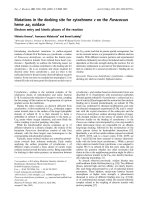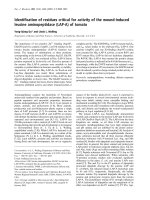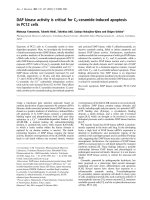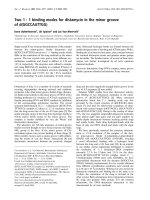Báo cáo y học: " High-intensity non-invasive positive pressure ventilation for stable hypercapnic COPD
Bạn đang xem bản rút gọn của tài liệu. Xem và tải ngay bản đầy đủ của tài liệu tại đây (190.88 KB, 5 trang )
Int. J. Med. Sci. 2009, 6
72
I
I
n
n
t
t
e
e
r
r
n
n
a
a
t
t
i
i
o
o
n
n
a
a
l
l
J
J
o
o
u
u
r
r
n
n
a
a
l
l
o
o
f
f
M
M
e
e
d
d
i
i
c
c
a
a
l
l
S
S
c
c
i
i
e
e
n
n
c
c
e
e
s
s
2009; 6(2):72-76
© Ivyspring International Publisher. All rights reserved
Research Paper
High-intensity non-invasive positive pressure ventilation for stable
hypercapnic COPD
Wolfram Windisch, Moritz Haenel, Jan H Storre and
Michael Dreher
Department of Pneumology, University Hospital Freiburg, Germany
Correspondence to: Michael Dreher, M.D., Department of Pneumology, University Hospital Freiburg, Killianstrasse 5, D -
79106 Freiburg. Tel.: +49 761 270-3706; Fax.: +49 761 270-3704; e-mail:
Received: 2009.02.03; Accepted: 2009.02.26; Published: 2009.02.27
Abstract
Background: The objective of the present analysis is to describe the outcomes of
high-intensity non-invasive positive pressure ventilation (NPPV) aimed at maximally de-
creasing PaCO
2
as an alternative to conventional NPPV with lower ventilator settings in
stable hypercapnic COPD patients.
Methods: Physiological parameters, exacerbation rates and long-term survival were as-
sessed in 73 COPD patients (mean FEV
1
30±12 %predicted) who were established on
high-intensity NPPV due to chronic hypercapnic respiratory failure between March 1997 and
May 2006.
Results: Controlled NPPV with breathing frequencies of 21±3 breath/min and mean inspi-
ratory/expiratory positive airway pressures of 28±5/5±1 cmH
2
O led to significant im-
provements in blood gases, lung function and hematocrit after two months. Only sixteen
patients (22%) required hospitalisation due to exacerbation during the first year, with
anaemia increasing the risk for exacerbation. Two- and five-year survival rates of all patients
were 82% and 58%, respectively. The five year survival rate was 32% and 83% in patients
with low (≤39%) and high (≥55%) hematocrit, respectively.
Conclusion: High-intensity NPPV improves blood gases, lung function and hematocrit, and
is also associated with low exacerbation rates and a favourable long-term outcome. The
current report strongly emphasises the need for randomised controlled trials evaluating the
role of high-intensity NPPV in stable hypercapnic COPD patients.
Key words: COPD, exacerbation, hematocrit, non-invasive ventilation, survival
Introduction
The effectiveness of non-invasive positive pres-
sure ventilation (NPPV) as a treatment for chronic
hypercapnic respiratory failure (HRF) arising from
COPD [1] remains debatable. Although long-term
NPPV is currently used in the treatment of COPD
patients in Europe [2], clinical outcomes such as sur-
vival, exacerbation and hospitalization rates have not
been clearly established in favor of NPPV [3, 4, 5].
However, most studies have used low levels of in-
spiratory support with inspiratory positive airway
pressures (IPAP) ranging from 12 to 18cmH
2
O. These
settings have not been shown to significantly improve
physiological parameters, particularly elevated
PaCO
2
levels [3, 4, 6]. In contrast, we have recently
shown that NPPV is well tolerated and leads to a
substantial improvement in blood gases and alveolar
ventilation during spontaneous breathing when ven-
tilator settings are markedly increased [7, 8, 9, 10].
Since this approach uses more intense ventilator set-
tings, we have labeled this form of treatment
Int. J. Med. Sci. 2009, 6
73
“high-intensity NPPV”.
The aim of the present report is to describe the
physiological and blood gas parameters, hospital
admissions and mortality in patients with stable, hy-
percapnic COPD treated with high-intensity NPPV.
Materials and Methods
The study protocol was approved by the Institu-
tional Review Board for Human Studies at the Al-
bert-Ludwigs University, Freiburg, Germany, and
was performed in accordance with the ethical stan-
dards laid down in the Declaration of Helsinki.
High-intensity NPPV
All patients were hospitalized to establish
high-intensity NPPV. The assist/control mode is used
for high-intensity NPPV, preferably in a pres-
sure-limited mode [7, 8, 9]. The major target for the
ventilatory adjustments (mainly increasing IPAP and
respiratory rate) is to achieve normocapnia. The initial
settings consist of the lowest back-up rates and trigger
threshold, with avoidance of auto triggering; these
settings are used in conjunction with low IPAP levels,
typically ranging between 12 and 16 cmH
2
O, and the
lowest expiratory positive airway pressures (EPAP)
levels. Subsequently, IPAP is carefully increased, step
by step, prior to the point where it is no longer toler-
ated by the patient. Next, the respiratory rate is in-
creased beyond the spontaneous rate to establish
controlled ventilation, while EPAP is set in order to
avoid dynamic hyperinflation; this is usually between
3 and 6 cmH
2
O, depending on individual tolerance.
NPPV is first used during daytime under careful su-
pervision, with the main aim of establishing NPPV
tolerance. When the patient is able to tolerate NPPV
for more than two hours, further ventilator adjust-
ments are performed in order to optimise alveolar
ventilation according to the results of arterial blood
gas (ABG) analysis. Further increases in respiratory
rate are aimed at a progressive decrease in PaCO
2
towards normocapnia, whilst maintaining an I:E ratio
of approximately 1:2. Once daytime NPPV is toler-
ated, nocturnal NPPV is commenced. The settings are
individually modified according to the patient’s com-
fort and nocturnal ABG. Nasal masks are initially
used, but patients are switched to oronasal masks if
there is increasing nocturnal PaCO
2
, indicative of
leakage. Passive humidification with a heat and
moisture exchanger is used according to patient
comfort, with a switch to active humidication using a
humidifier if airway dryness persists. Finally, patients
are instructed to use the ventilator for the entire night,
as well as during any naps taken during the daytime.
Patients and data collection
All patients presenting with stable hypercapnic
COPD, as diagnosed according to international
guidelines [11], and who received high-intensity
NPPV between March 1997 and May 2006 at the De-
partment of Pneumology, University Hospital
Freiburg, Germany, were registered in a hospital da-
tabase and included for analysis. Patients were ex-
cluded if they were established on NPPV during acute
HRF (including one of the following symptoms:
breathing frequency >30 per minute, pH <7.35), or
received any form of invasive ventilation in the past.
Furthermore, patients with obesity (BMI>35kg/m
2
)
were excluded.
The following data were analysed: patients’
characteristics, ventilator settings, blood gases at day-
time under rest, lung function testing, mouth occlu-
sion pressures, hematocrit (three groups: ≤39, 40 to 54
and ≥55%), haemoglobin levels, and long-term sur-
vival. In addition, hospitalisation for routine check of
NPPV, for management of problems related to NPPV
such as mask problems and for severe exacerbation
[12] during the first year of NPPV was assessed
Statistical Analysis
Statistical analysis was performed using
Sigma-Stat
®
(Version 3.1, Systat Software, Inc., Point
Richmond, California, USA). Mean values ± standard
deviation were given after testing for normal distri-
bution (Kolmogorov-Smirnov test). For non-normally
distributed data, the median and interquartile ranges
are given. Follow-up measurements were performed
using the paired t- test for normally distributed data
and the Wilcoxon signed rank test for non-normally
distributed data. Five-year survival rates were as-
sessed by Kaplan-Meier actuarial curve analysis. Sta-
tistical significance was assumed with a p-value <0.05.
Results
Twenty women and 53 men, for whom COPD
was the leading cause of chronic HRF, and who were
established on high-intensity NPPV, were identified
from the database. Mean age was 64.2±9.6 years and
mean body mass index (BMI) was 27.6±6.7 kg/m
2
.
Mean cumulative smoking history was 41.9±28.5
pack-years. Pressure-limited NPPV was applied in 69
patients (Table 1), whereas four patients were estab-
lished on volume-limited NPPV, due to better toler-
ance with a mean tidal volume of 683±197 ml and a
mean breathing frequency of 21.3±3.8/min. Changes
in physiological parameters after two months of
NPPV are given in Table 2. After one year of NPPV,
PaCO
2
decreased from 51.7±6.6 to 44.9±12.7 (95%CI
Int. J. Med. Sci. 2009, 6
74
-11.6/-1.9; p=0.008) while PaO
2
increased from
53.1±8.9 to 65.1±11.7 (95%CI 7.6/15.6; p<0.001). In 13
patients (18%), hematocrit was ≤39%; in 53 patients
(73%), hematocrit ranged from 40 to 54%; and in seven
patients (9%), hematocrit was ≥55%. Although hema-
tocrit decreased significantly in the total group after
two months of NPPV (Table 2), hematocrit increased
from 36.2 (interquartile range 35.8/38.9) to 37.5 (in-
terquartile range 36.0/39.5)% (p=0.016) in patients
with an initial hematocrit ≤39%, but decreased from
55.8±0.9 to 48.2±5.7% (95%CI -13.6/-1.6; p=0.022) in
patients with an initial hematocrit ≥55%, and from 46
(interquartile range 43.1/48.9) to 44.2 (interquartile
range 42.1/46.3)% (p=0.008) in patients with an initial
hematocrit ranging from 40 to 54%.
Table 1. Ventilator settings for 69 patients receiving
pressure-limited NPPV
Mean ± SD Min Max
IPAP (cmH
2
O) 28.0 ± 5.4 17 42
EPAP (cmH
2
O)
4.6 ± 1.3 2 9
b
f
(/min) 21.0 ± 2.8 10 26
Supplemental oxygen
(l/min)
1.6 ± 1.5 0 6
IPAP = inspiratory positive airway pressure, EPAP = expiratory
airway pressure, b
f
= breathing frequency; SD = standard deviation.
Table 2. Blood gas levels, lung function parameters, mouth occlusion pressures, hemoglobin and hematocrit prior to NPPV
and 2 months after establishment of NPPV.
Variables prior to NPPV After 2 months of NPPV 95 % CI for the difference p-value
pH 7.40 ± 0.04 7.40 ± 0.03 -0.01 / 0.02 0.598
PaCO
2
(mmHg) 51.2 ± 6.5 46.8 ± 5.8 -6.2 / -2.0 <0.001
PaO
2
(mmHg) 53.0 ± 8.1 58.0 ± 8.3 2.1 / 7.9 0.001
HCO
3
-
(mmol/L) 31.3 ± 5.7 28.7 ± 5.4 -4.0 / -1.2 <0.001
TLC (%pred.) 109.2 ± 22 109.3 ± 21.6 n.f. 0.419
FVC (%pred.) 49.3 ± 13.3 54.6 ± 13.7 2.2 / 8.2 <0.001
FEV
1
(%pred.) 30.1 ± 12.2 34.6 ± 13.6 2.4 / 6.6 <0.001
FEV
1
/FVC (%) 43.6 ± 10.1 45.6 ± 10.7 n.f. 0.68
P0.1 (kPa) 0.60 ± 0.57 0.46 ± 0.26 n.f. 0.056
PImax (kPa) 4.7 ± 2.3 5.6 ± 2.5 n.f. 0.501
Hb (g/dl) 14.6 ± 2.0 14.2 ± 1.7 -0.9 / -0.1 0.093
Hkt (%) 45.1 ± 6,5 43.7 ± 5.9 n.f. 0.005
n.f. = normality test failed. PaCO
2
= arterial partial pressure of carbon dioxide, PaO
2
= arterial partial pressure of oxygen, HCO
3
- = bicar-
bonate, TLC = total lung capacity, FVC = forced vital capacity, FEV
1
= forced expiratory volume in one second, P0.1 = mouth occlusion
pressure 0.1 seconds after the onset of inspiration during normal breathing, PImax
peak
= peak maximal inspiratory mouth pressure according
to previous findings [21], Hb = hemoglobin, HKT = hematocrit.
Routine checks were performed 1.9±0.8 times in
the first year (9.1±6.3 days in hospital). Additionally,
11 patients (15%) were admitted to hospital on 1.3±0.9
occasions for the management of problems associated
with NPPV (8.0±5.8 days in hospital). Sixteen patients
(22%) required hospitalisation 1.3±0.6 times (19.3±10.9
days) during the first year due to exacerbation (one of
these patients died in hospital and two patients re-
quired ICU admission with one requiring intubation).
Hospitalisation for an acute exacerbation was re-
quired in five patients (46%) with a hematocrit <39%,
while no patient with a hematocrit >55% was hospi-
talised in the first year following commencement of
NPPV. In all patients, two- and five-year survival
rates were 82±5% and 58±8%, respectively. The me-
dian survival was 78 months. In those patients with a
hematocrit <39%, five year survival was 32%, com-
pared to 83% in those with a hematocrit >55%.
Discussion
Stable hypercapnic COPD-patients analysed in
the present study performed high-intensity NPPV
over several years and thereby demonstrated an im-
provement in blood gases; this is in agreement with
previous findings [7, 8, 9]. The present study extends
the existing experience with high-intensity NPPV in
COPD by particularly addressing important clinical
aspects of its impact on exacerbation and hospitalisa-
tion. As shown in the present study hospitalisa-
tion-rates are acceptable once high-intensity NPPV
has been successfully established. Importantly, only
22% of patients required hospitalisation due to exac-
Int. J. Med. Sci. 2009, 6
75
erbation during the first year, with most patients be-
ing successfully treated on the general ward. This
challenges previous findings, where >50% of patients
required hospitalisation during a one year follow-up,
although the disease in these patients was less ad-
vanced [13].
Moreover, the five year survival rate was 58%,
suggesting that high-intensity NPPV has survival
benefits compared to historical data [14, 15, 16].
Anaemia was associated with higher rates of exacer-
bation and reduced long-term survival, confirming
previous findings [17]. The present study gives un-
controlled evidence that hematocrit has an important
impact on long-term outcome in COPD-patients re-
ceiving home mechanical ventilation. However, he-
matocrit also normalised within two months of
high-intensity NPPV. In addition, there was an im-
provement in lung function parameters, which is in
line with previous studies [8, 18]. The explanation for
this observation remains unclear. However, hyper-
capnia, with consequent dilation of precapillary
sphincters, is believed to be the predominant factor
causing edema in patients with severe COPD [19].
Since this edema could also affect the bronchial tree,
improvements of lung function might be attributed to
the decrease in PaCO
2
, thus reversing bronchial
edema. However, this remains speculative and needs
to be investigated in future studies. Finally, overall
health-related quality of life has most recently been
shown to increase substantially following the estab-
lishment of high-intensity NPPV, and these im-
provements were reported to be similar when com-
pared to patients with neuromuscular and thoracic
restrictive diseases [20].
Several questions, however, need to be ad-
dressed: Firstly, selection criteria must be established.
Unfortunately, this was not performed in the present
study due to its retrospective nature. Secondly,
drop-outs and compliance rates have not been quan-
tified. This seems to be important as selection of those
patients who tolerate high-intensity NPPV would
result in better outcomes. Therefore, prospective trials
also assessing the number of patients not tolerating
high-intensity NPPV are required. Thirdly,
high-intensity NPPV, as described in the present
study, seems to be the extreme opposite to the con-
ventional technique of using considerably lower ven-
tilator settings. Therefore, controlled studies are
needed to compare these techniques in the future.
In conclusion, application of high-intensity
NPPV, described both here and in the literature, im-
proves alveolar ventilation and consequently blood
gases during spontaneous breathing, as well as lung
function and hematocrit in stable hypercapnic COPD
patients. In addition, with regard to the present study,
there is uncontrolled evidence of high-intensity NPPV
being capable of reducing exacerbation rates and im-
proving long-term survival. Therefore, the current
report strongly emphasises the need for randomised
controlled trials evaluating the role of high-intensity
NPPV in COPD patients with chronic HRF.
Acknowledgements
We would like to thank Dr. Sandra Dieni for
proofreading the manuscript prior to submission.
Competing interest
The study group received an open research grant
from Breas Medical AB, Molnlycke, Sweden. The au-
thors state that neither the study design, the results,
the interpretation of the findings, nor any other sub-
ject discussed in the submitted manuscript was de-
pendent on support.
References
[1] Kolodziej MA, Jensen L, Rowe B, Sin D. Systematic review of
noninvasive positive pressure ventilation in severe stable
COPD. Eur Respir J. 2007; 30:293-306.
[2] Lloyd-Owen SJ, Donaldson GC, Ambrosino N et al. Patterns of
home mechanical ventilation use in Europe: results from the
Eurovent survey. Eur Respir J. 2005; 25:1025-31.
[3] Casanova C, Celli BR, Tost L et al. Long-term controlled trial of
nocturnal nasal positive pressure ventilation in patients with
severe COPD. Chest. 2000; 118:1582-90.
[4] Clini E, Sturani C, Rossi A et al. The Italian multicentre study
on noninvasive ventilation in chronic obstructive pulmonary
disease patients. Eur Respir J. 2002; 20:529-38.
[5] Wijkstra PJ. Non-invasive positive pressure ventilation
(NIPPV) in stable patients with chronic obstructive pulmonary
disease (COPD). Respir Med. 2003; 97:1086-93.
[6] Wijkstra PJ, Lacasse Y, Guyatt GH et al. A meta-analysis of
nocturnal noninvasive positive pressure ventilation in patients
with stable COPD. Chest. 2003; 124:337-43.
[7] Windisch W, Vogel M, Sorichter S et al. Normocapnia during
nIPPV in chronic hypercapnic COPD reduces subsequent
spontaneous PaCO
2
. Respir Med. 2002; 96:572-9.
[8] Windisch W, Kostic S, Dreher M, Virchow JCJ, Sorichter S.
Outcome of patients with stable COPD receiving controlled
noninvasive positive pressure ventilation aimed at a maximal
reduction of PaCO
2
. Chest. 2005; 128:657-62.
[9] Windisch W, Dreher M, Storre JH, Sorichter S. Nocturnal
non-invasive positive pressure ventilation: Physiological effects
on spontaneous breathing. Respir Physiol Neurobiol. 2006;
150:251-60.
[10] Dreher M, Storre JH, Windisch W. Noninvasive ventilation
during walking in patients with severe COPD: a randomised
cross-over trial. Eur Respir J. 2007; 29:930-6.
[11] Sutherland ER, Cherniack RM. Management of chronic ob-
structive pulmonary disease. N Engl J Med. 2004; 350:2689-97.
[12] Rodriguez-Roisin R. Toward a consensus definition for COPD
exacerbations. Chest. 2000; 117:398S-401S.
[13] Casas A, Troosters T, Garcia-Aymerich J et al. Integrated care
prevents hospitalisations for exacerbations in COPD patients.
Eur Respir J. 2006; 28:123-30.
Int. J. Med. Sci. 2009, 6
76
[14] Simonds AK, Elliott MW. Outcome of domiciliary nasal inter-
mittent positive pressure ventilation in restrictive and obstruc-
tive disorders. Thorax. 1995; 50:604-9.
[15] Sivasothy P, Smith IE, Shneerson JM. Mask intermittent posi-
tive pressure ventilation in chronic hypercapnic respiratory
failure due to chronic obstructive pulmonary disease. Eur Respir
J. 1998; 11:34-40.
[16] Leger P, Bedicam JM, Cornette A et al. Nasal intermittent posi-
tive pressure ventilation. Long-term follow-up in patients with
severe chronic respiratory insufficiency. Chest. 1994; 105:100-5.
[17] Chambellan A, Chailleux E, Similowski T. Prognostic value of
the hematocrit in patients with severe COPD receiving
long-term oxygen therapy. Chest. 2005; 128:1201-8.
[18] Budweiser S, Jorres RA, Riedl T et al. Predictors of survival in
COPD patients with chronic hypercapnic respiratory failure
receiving noninvasive home ventilation. Chest. 2007; 131:1650-8.
[19] de Leeuw PW, Dees A. Fluid homeostasis in chronic obstructive
lung disease. Eur Respir J Suppl. 2003; 46:33s-40s.
[20] Windisch, W. Impact of home mechanical ventilation on
health-related quality of life. Eur Respir J. 2008
Nov;32(5):1328-36.
[21] Windisch W, Hennings E, Sorichter S, Hamm H, Criee CP. Peak
or plateau maximal inspiratory mouth pressure: which is best?
Eur Respir J. 2004; 23:708-13.








